

Achieved next stage SEO II with Hubspot. The course covered:
> Google Page Experience and Core Web Vitals
> Improving Your Technical SEO
> SEO for Website Migration
> SEO Performance Analytics
The Page Experience report gives an overview of how users interacted with your website. In order to determine a URL’s ranking in Google Search results, Google analyses page experience characteristics for each individual URL on your website.
Core Web Vitals is a set of metrics that gauges the actual user experience in terms of the page’s visual stability, interactivity, and loading speed.
I would be happy to administer your website and offer any recommendations for changes that can enhance user experience. Feel free to send Ronna an email at contact[at]ronna.com with a brief statement outlining what you require.
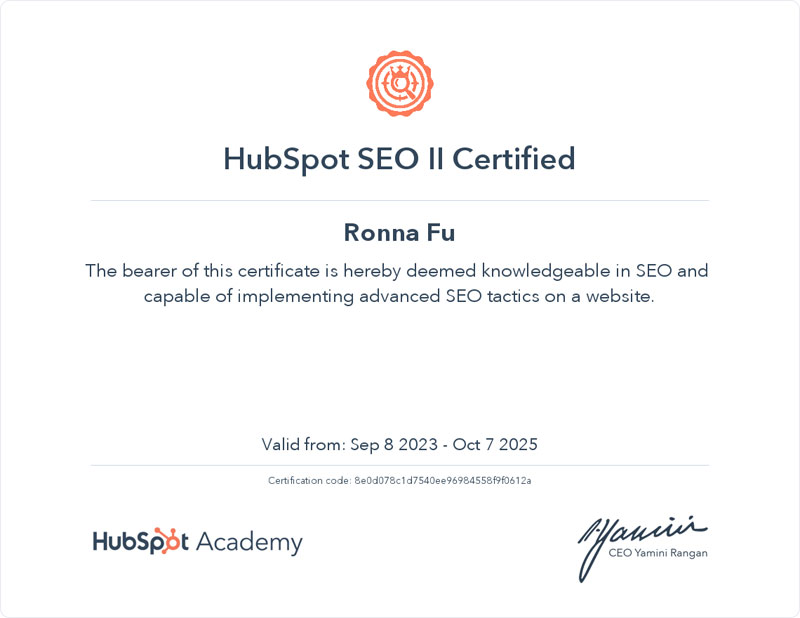
I have just completed the first SEO (Search Engine Optimisation) training with HubSpot. Moving on to the next step, ie, SEO II. I have been studying more than usual to keep up with social media marketing, SEO and any topics related to equip me serving my customers better.
Below is my certificate of achievement from HubSpot. HubSpot is a digital marketing industry leader, and their blogs, videos, and certification courses are very popular. The cloud-based CRM HubSpot was created to aid in the alignment of sales and marketing teams, promote sales enablement, increase ROI, and optimise inbound marketing strategy to produce more qualified leads.
I would be pleased to manage your website and make any suggestions for adjustments that can enhance user experience. Please feel free to drop Ronna an email and include a brief message describing what you need done.
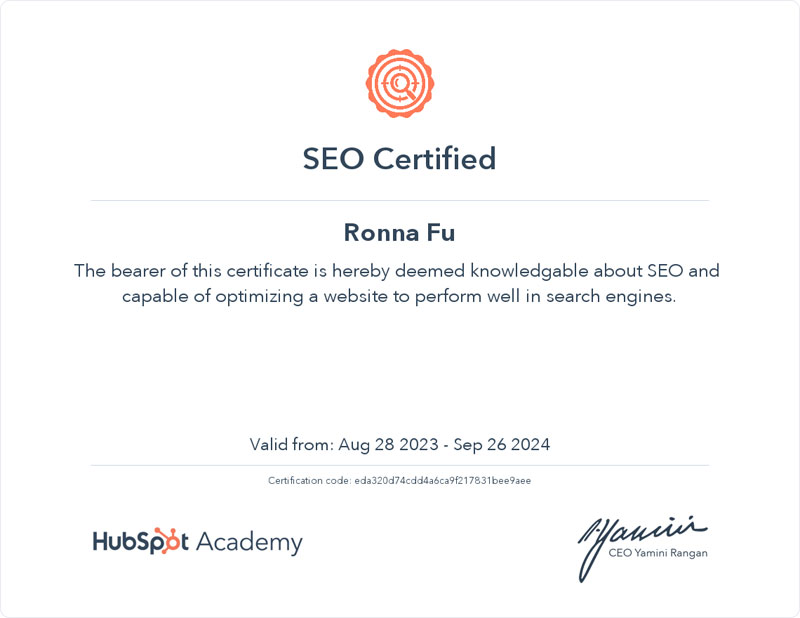
I previously completed a course called SEO Strategies through Great Learning. Great Learning provides online traning on topics like AI, ML, data science, digital marketing, cloud, software engg & more.
The course covers the following topics:
> Introduction to Digital Marketing?
> Why Digital Marketing?
> SEO and working with SEO
> Keyword and SERP Analysis
> Original and Quality Content
> Understanding Local SEO, Optimisation
> Understanding Customer and Performance Matrix
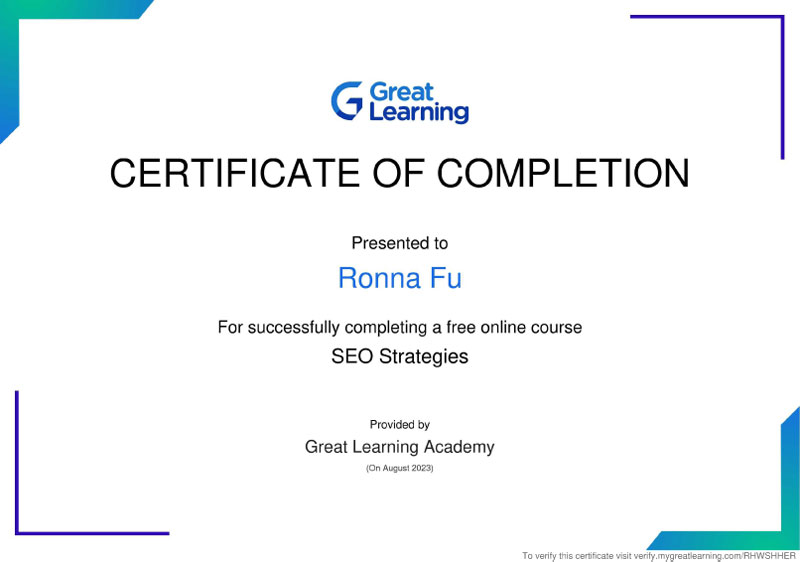
In the realm of design, UI (User Interface) and UX (User Experience) are two terms that are closely related, particularly in the context of software, websites, and applications. They both are essential to creating products that are appealing to the eye, simple to use, and give customers a satisfying experience. They do, however, concentrate on various elements of the design process.
The term “UI” describes the visual components and product design that people directly interact with. It encompasses every visual element that people see and interact with on a screen, such as buttons, menus, forms, typography, colours, icons, and layout. The aim of user interface design is to produce a visually appealing and unified depiction of a product. A user interface (UI) that is well-designed improves the product’s aesthetic appeal and makes it simpler for consumers to explore, comprehend, and interact with the features.
Selecting suitable fonts, symbols, colours, and images that represent the brand and deliver the desired message.
Organising the components on the screen ensuring a balanced and consistent layout by logically and user-friendly
Designing buttons, forms, and other interactive features so that they respond to user inputs in an understandable and natural way is known as interactivity.
Maintaining a coherent and recognisable design language throughout the entire product to achieve consistency.
Giving consumers visible cues as they interact with items, including clicking buttons or submitting forms.
While using a product or service, a user’s overall experience (UX) is the main emphasis of this field of study. It covers every facet of the user’s engagement, such as how simple or complex it is to use, how effectively it satisfies their needs, and if the experience is pleasurable or frustrating. The goal of UX design is to develop products that are user-centered, useful, and beneficial to the user.
Using techniques like surveys, interviews, and usability testing to better understand the wants, needs, and taste of the target market.
The process of structuring and arranging features and material so that users may quickly discover what they need.
Drawing out a diagram of the routes customers travel through the system to complete particular tasks, pointing out problems and potential improvements.
Making low- or high-fidelity prototypes allows you to visualise and test various design concepts prior to actual development.
It involves obtaining input from actual users in order to pinpoint problems and improve the design in light of their interactions and feedback.
In conclusion, UI and UX are essential elements of the design process and each serves create products that are not only aesthetically pleasing but also easy to use and pleasurable to employ. Finding the ideal balance between UI elements that grab the user’s attention and UX guidelines that guarantee a seamless and successful user experience is essential for successful design.
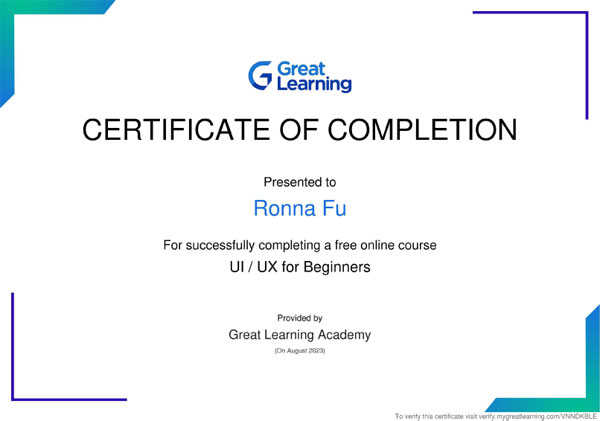
A Google Search campaign is a particular type of online marketing campaign that runs through Google Ads, formerly known as Google AdWords, Google’s platform for online marketing. When consumers conduct a Google search for a certain keyword, text advertising are intended to be displayed to them.
Google Search campaigns are an effective approach to reach people who are looking for items or services similar to yours right now. They enable you to connect with a very targeted audience and track the success of your campaign using statistics like clicks, impressions, click-through rate (CTR), and conversion rate.
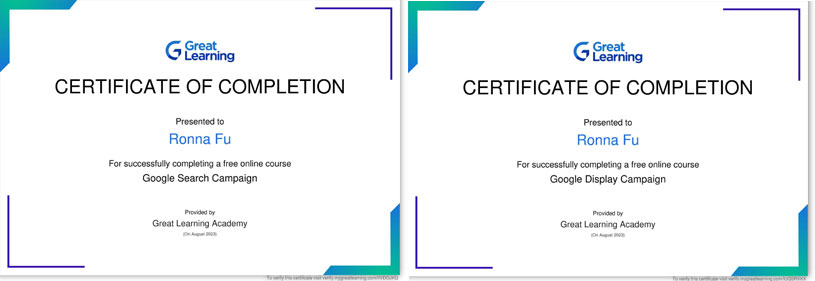
Choosing keywords that are pertinent to your enterprise, goods, or services is the first step in conducting keyword research. These are the terms and phrases that customers might type into the Google search box to find products and services similar to yours.
You produce text-based advertisements that are pertinent to the selected keywords. Every advertisement normally has a headline, a few lines of information, and a display URL.
The maximum bid that you set for each term is what you’re willing to spend when someone clicks on your ad. The position of your ad on the search results page is determined by this bid together with other elements like ad relevancy and quality score.
Google’s Ad Rank algorithm determines the position of the adverts on the search results page. Your bid, ad quality, anticipated click-through rate, ad relevancy, landing page experience, and other variables are used to determine your ad rank.
Google’s algorithm chooses which advertisements to display when consumers search for a keyword you’re targeting depending on the Ad Rank. Depending on the competition and your bid, your ad may appear at the top, bottom, or side of the search results page.
The cost-per-click (CPC) bidding mechanism determines how much you are charged if a user clicks on your advertisement. The most you’re willing to spend on the campaign is your budget.
A user is taken to a landing page on your website when they click on your advertisement. The landing page should give a positive visitor experience and be pertinent to the advertisement.
You keep an eye on the campaign’s effectiveness using the reporting tools provided by Google Ads. To increase the effectiveness of the campaign, you can change bids, add new keywords, halt underperforming advertisements, and execute other optimisations.
ChatGPT is a language model developed by Open AI. It creates text that appears human. It belongs to the larger family of GPT (Generative Pre-trained Transformer) models. ChatGPT can answer queries, produce text, give explanations, and conduct other natural language processing tasks because it has been trained on a wide variety of internet text. It’s frequently employed in chatbot applications, virtual assistants, content creation, and other applications.
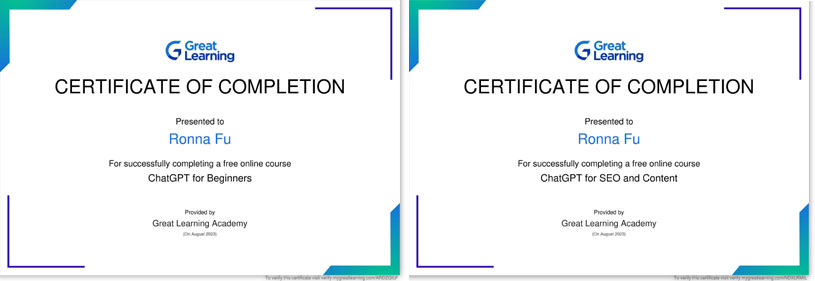
I recently finished two ChatGPT courses offered by Greater Learning. ChatGPT basics was the first course. I made the decision to continue learning ChatGPT for SEO and Content because I wanted to deepen my understanding of the topic.
It can be very successful to use ChatGPT for SEO (Search Engine Optimisation) and content generation. Here’s how to use ChatGPT for these objectives:
ChatGTP can help you with the creation of relevant and high-quality material for your website, blog, or social media platforms. You can use it to write articles, product descriptions, and more, as well as to brainstorm ideas. Simply give ChatGPT a topic or a brief, and it will generate material for you.
You can find suitable keywords for your content with the aid of ChatGPT. Describe your subject or sector, and ChatGPT will offer suggestions for keywords that will boost the SEO of your material. Long-tail keywords, which are more particular and have less competition, can also be requested.
You can use ChatGPT to get ideas for engaging article titles and persuading meta descriptions. These are essential for increasing click-through rates and attracting visitors’ attention in search engine results.
If you provide ChatGPT access to your current material, it can make recommendations on how to improve its search engine exposure. It can help you find areas in which you can organically add keywords, make your writing easier to read, and increase user engagement.
ChatGPT can offer suggestions for a content calendar and plan your content marketing objectives. Based on your target demographic and current market trends, it can recommend content subjects, formats, and distribution methods.
Use ChatGPT as a chatbot on your website to respond to frequent user questions. By doing this, you can improve user experience, lower bounce rates, and maintain visitors’ interest in your website.
If your company has a physical presence, ChatGPT can assist you in developing content for local SEO campaigns. It can produce localised content like directions, neighbourhood guides, and event notices.
Technical SEO terms like website structure, schema markup, and mobile optimisation can be explained with help from ChatGPT. You can use this to better comprehend search engine optimisation for your website.
Use ChatGPT to create FAQs and how-to manuals for your goods or services. This can increase the authority of your website and give visitors useful information.
*search engine landscape evolves over time, You need to stay up-to-date with the latest SEO best practices.